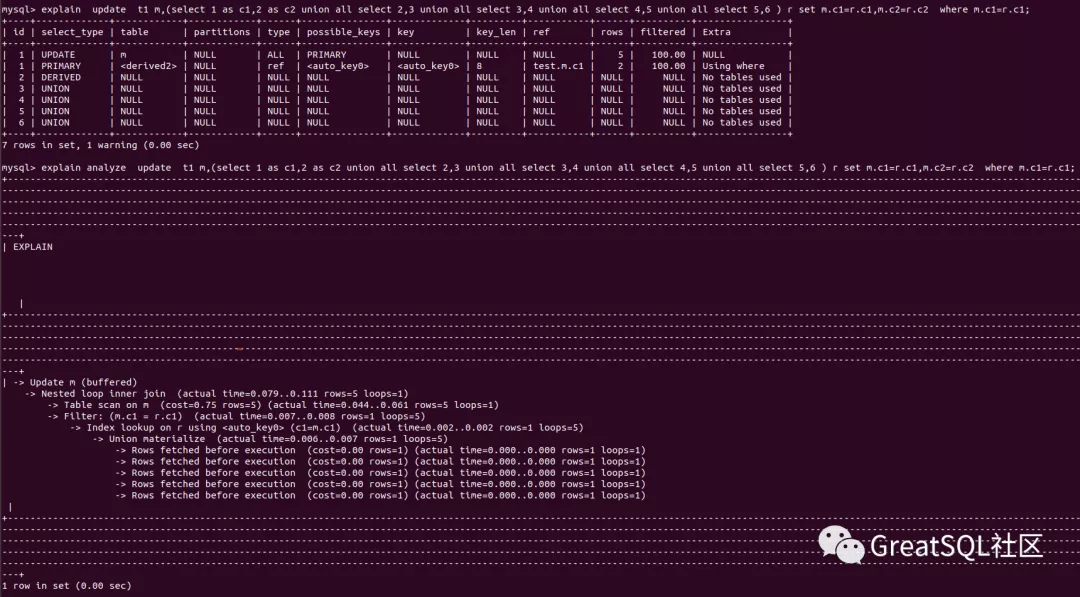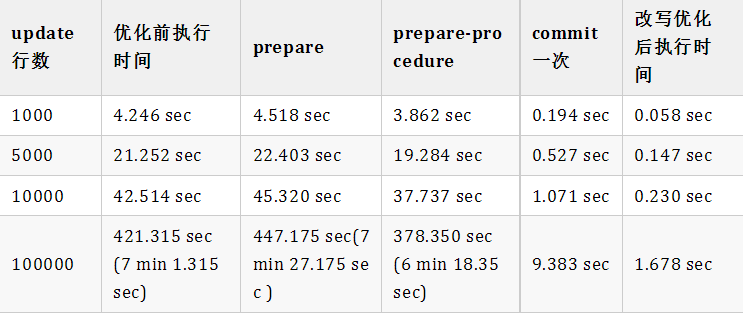| 技术分享 | 您所在的位置:网站首页 › sql语句执行效率 › 技术分享 |
技术分享
|
欢迎来到 GreatSQL社区分享的MySQL技术文章,如有疑问或想学习的内容,可以在下方评论区留言,看到后会进行解答 作者:景云丽、卢浩、宋源栋 GreatSQL社区原创内容未经授权不得随意使用,转载请联系小编并注明来源。 引言批量更新数据,不同于这种 update a=a+1 where pk > 500,而是需要对每一行进行单独更新 update a=1 where pk=1;update a=12 where pk=7;... 这样连续多行update语句的场景,是少见的。 可以说是偶然也是一种必然,在GreatDB 5.0的开发过程中,我们需要对多语句批量update的场景进行优化。 两种多行更新操作的耗时对比 在我们对表做多行更新的时候通常会遇到以下两种情况 1.单语句批量更新(update a=a+1 where pk > 500) 2.多语句批量更新(update a=1 where pk=1;update a=12 where pk=7;...) 下面我们进行实际操作比较两种场景,在更新相同行数时所消耗的时间。 数据准备数据库版本:MySQL 8.0.23 t1表,建表语句以及准备初始数据1000行 create database if not exists test; use test ##建表 create table t1(c1 int primary key,c2 int); ##创建存储过程用于生成初始数据 DROP PROCEDURE IF EXISTS insdata; DELIMITER $$ CREATE PROCEDURE insdata(IN beg INT, IN end INT) BEGIN WHILE beg update.sql done生成sql语句如下 update t1 set c2=292 where c1=1; update t1 set c2=475 where c1=2; update t1 set c2=470 where c1=3; update t1 set c2=68 where c1=4; update t1 set c2=819 where c1=5; ... .... update t1 set c2=970 where c1=1000;因为source /ssd/tmp/tmp/1000/update.sql;执行结果如下,执行时间不易统计: Query OK, 1 row affected (0.00 sec) Rows matched: 1 Changed: 1 Warnings: 0 Query OK, 1 row affected (0.01 sec) Rows matched: 1 Changed: 1 Warnings: 0 Query OK, 1 row affected (0.00 sec) Rows matched: 1 Changed: 1 Warnings: 0 Query OK, 1 row affected (0.00 sec) Rows matched: 1 Changed: 1 Warnings: 0 Query OK, 1 row affected (0.01 sec) Rows matched: 1 Changed: 1 Warnings: 0 Query OK, 1 row affected (0.00 sec) Rows matched: 1 Changed: 1 Warnings: 0 Query OK, 1 row affected (0.01 sec) Rows matched: 1 Changed: 1 Warnings: 0所以利用Linux时间戳进行统计: #!/bin/bash start_time=`date +%s%3N` /ssd/tmp/mysql/bin/mysql -h127.0.0.1 -uroot -P3316 -pabc123 -e "use test;source /ssd/tmp/tmp/1000/update.sql;" end_time=`date +%s%3N` echo "执行时间为:"$(($end_time-$start_time))"ms"执行结果: [root@computer-42 test]# bash update.sh mysql: [Warning] Using a password on the command line interface can be insecure. 执行时间为:4246ms执行所用时间为:4246ms=4.246 sec 结果比较
总结 由上述例子我们可以看到,同样是更新1000行数据。单语句批量更新与多语句批量更新的执行效率差距很大。 而产生这种巨大差异的原因,除了1000行sql语句本身的网络与语句解析开销外,影响性能的地方主要是以下几个方面: 1.如果会话是auto_commit=1,每次执行update语句后都要执行commit操作。commit操作耗费时间较久,会产生两次磁盘同步(写binlog和写redo日志)。在进行比对测试时,尽量将多个语句放到一个事务内,保证只提交一次事务。 2.向后端发送多语句时,后端每处理一个语句均会向client返回一个response包,进行一次交互。如果多语句使用一个事务的话,网络io交互应该是影响性能的主要方面。之前在性能测试时发现网卡驱动占用cpu很高。 我们的目标是希望在更新1000行时,第二种场景的耗时能够减少到一秒以内。 对第二种场景的优化接下来我们来探索对更新表中多行为不同值时,如何提高它的执行效率。 简单分析从执行的update语句本身来说,两种场景所用的表结构都进行了最大程度的简化,update语句也十分简单,且where条件为主键,理论上已经没有优化的空间。 如果从其他方面来考虑,根据上述原因分析会有这样三个优化思路: 1.减少执行语句的解析时间来提高执行效率 2.减少commit操作对性能的影响,尽量将多个语句放到一个事务内,保证只提交一次事务。 3.将多条语句合并成一条来提高执行效率 方案一:使用prepare语句,减小解析时间以下脚本用于生成prepare执行语句 #!/bin/bash echo "prepare pr1 from 'update test.t1 set c2=? where c1=?';" > prepare.sql for i in {1..1000} do echo "set @a=$((RANDOM%1000+1)),@b=$i;" >>prepare.sql echo "execute pr1 using @a,@b;" >> prepare.sql done echo "deallocate prepare pr1;" >> prepare.sql生成语句如下 prepare pr1 from 'update test.t1 set c2=? where c1=?'; set @a=276,@b=1; execute pr1 using @a,@b; set @a=341,@b=2; execute pr1 using @a,@b; set @a=803,@b=3; execute pr1 using @a,@b; ... ... set @a=582,@b=1000; execute pr1 using @a,@b; deallocate prepare pr1;执行语句 #!/bin/bash start_time=`date +%s%3N` /ssd/tmp/mysql/bin/mysql -h127.0.0.1 -uroot -P3316 -pabc123 -e "use test;source /ssd/tmp/tmp/test/prepare.sql;" end_time=`date +%s%3N` echo "执行时间为:"$(($end_time-$start_time))"ms"执行结果: [root@computer-42 test]# bash prepare_update_id.sh mysql: [Warning] Using a password on the command line interface can be insecure. 执行时间为:4518ms与优化前相比
很遗憾,执行总耗时反而增加了。 这里笔者有一点推测是由于原本一条update语句,被拆分成了两条语句: set @a=276,@b=1; execute pr1 using @a,@b;这样在MySQL客户端和MySQL进程之间的通讯次数增加了,所以增加了总耗时。 因为prepare预处理语句执行时只能使用用户变量传递,以下执行语句会报错 mysql> execute pr1 using 210,5; ERROR 1064 (42000): You have an error in your SQL syntax; check the manual that corresponds to your MySQL server version for the right syntax to use near '210,5' at line 1所以无法在语法方面将两条语句重新合并,笔者便使用了以下另外一种执行方式 执行语句 #!/bin/bash start_time=`date +%s%3N` /ssd/tmp/mysql/bin/mysql -h127.0.0.1 -uroot -P3316 -pabc123 update.sql done echo "commit;" >> update.sql生成sql语句如下 begin; update t1 set c2=279 where c1=1; update t1 set c2=425 where c1=2; update t1 set c2=72 where c1=3; update t1 set c2=599 where c1=4; update t1 set c2=161 where c1=5; ... .... update t1 set c2=775 where c1=1000; commit;执行时间统计的方法,同上 [root@computer-42 test]# bash update.sh mysql: [Warning] Using a password on the command line interface can be insecure. 执行时间为:194ms执行时间为194ms=0.194sec 与优化前相比:
可以看出多次commit操作对性能的影响还是很大的。 方案三:使用特殊SQL语法,将多个update语句合并合并多条update语句 在这里我们引入一种并不常用的MySQL语法: 1)优化前: update多行执行语句类似“update xxx; update xxx;update xxx;... ...” 2)优化后: 改成先把要更新的语句拼成一个视图(结果集表),然后用结果集表和源表进行关联更新。这种更新方式有个隐式限制“按主键或唯一索引关联更新”。 UPDATE t1 m, ( SELECT 1 AS c1, 2 AS c2 UNION ALL SELECT 2, 2 UNION ALL SELECT 3, 3 ... ... UNION ALL SELECT n, 2 ) r SET m.c1 = r.c1, m.c2 = r.c2 WHERE m.c1 = r.c1;3)具体的例子: ###建表 create table t1(c1 int primary key,c2 int); ###插入5行数据 insert into t1 values(1,1),(2,1),(3,1),(4,1),(5,1); select * from t1; ###更新c2为c1+1 UPDATE t1 m, ( SELECT 1 AS c1, 2 AS c2 UNION ALL SELECT 2, 3 UNION ALL SELECT 3, 4 UNION ALL SELECT 4, 5 UNION ALL SELECT 5, 6 ) r SET m.c1 = r.c1, m.c2 = r.c2 WHERE m.c1 = r.c1; ###查询结果 select * from t1;执行结果: mysql> create table t1(c1 int primary key,c2 int); Query OK, 0 rows affected (0.03 sec) mysql> insert into t1 values(1,1),(2,1),(3,1),(4,1),(5,1); Query OK, 5 rows affected (0.00 sec) Records: 5 Duplicates: 0 Warnings: 0 mysql> select * from t1; +----+------+ | c1 | c2 | +----+------+ | 1 | 1 | | 2 | 1 | | 3 | 1 | | 4 | 1 | | 5 | 1 | +----+------+ 5 rows in set (0.00 sec) mysql> update t1 m,(select 1 as c1,2 as c2 union all select 2,3 union all select 3,4 union all select 4,5 union all select 5,6 ) r set m.c1=r.c1,m.c2=r.c2 where m.c1=r.c1; Query OK, 5 rows affected (0.01 sec) Rows matched: 5 Changed: 5 Warnings: 0 mysql> select * from t1; +----+------+ | c1 | c2 | +----+------+ | 1 | 2 | | 2 | 3 | | 3 | 4 | | 4 | 5 | | 5 | 6 | +----+------+ 5 rows in set (0.00 sec)4)更进一步的证明 在这里笔者选择通过观察语句执行生成的binlog,来证明优化方式的正确性。 首先是未经优化的语句: begin; update t1 set c2=2 where c1=1; update t1 set c2=3 where c1=2; update t1 set c2=4 where c1=3; update t1 set c2=5 where c1=4; update t1 set c2=6 where c1=5; commit; ...... ### UPDATE `test`.`t1` ### WHERE ### @1=1 /* INT meta=0 nullable=0 is_null=0 */ ### @2=1 /* INT meta=0 nullable=1 is_null=0 */ ### SET ### @1=1 /* INT meta=0 nullable=0 is_null=0 */ ### @2=2 /* INT meta=0 nullable=1 is_null=0 */ ...... ### UPDATE `test`.`t1` ### WHERE ### @1=2 /* INT meta=0 nullable=0 is_null=0 */ ### @2=1 /* INT meta=0 nullable=1 is_null=0 */ ### SET ### @1=2 /* INT meta=0 nullable=0 is_null=0 */ ### @2=3 /* INT meta=0 nullable=1 is_null=0 */ ...... ### UPDATE `test`.`t1` ### WHERE ### @1=3 /* INT meta=0 nullable=0 is_null=0 */ ### @2=1 /* INT meta=0 nullable=1 is_null=0 */ ### SET ### @1=3 /* INT meta=0 nullable=0 is_null=0 */ ### @2=4 /* INT meta=0 nullable=1 is_null=0 */ ...... ### UPDATE `test`.`t1` ### WHERE ### @1=4 /* INT meta=0 nullable=0 is_null=0 */ ### @2=1 /* INT meta=0 nullable=1 is_null=0 */ ### SET ### @1=4 /* INT meta=0 nullable=0 is_null=0 */ ### @2=5 /* INT meta=0 nullable=1 is_null=0 */ ...... ### UPDATE `test`.`t1` ### WHERE ### @1=5 /* INT meta=0 nullable=0 is_null=0 */ ### @2=1 /* INT meta=0 nullable=1 is_null=0 */ ### SET ### @1=5 /* INT meta=0 nullable=0 is_null=0 */ ### @2=6 /* INT meta=0 nullable=1 is_null=0 */ ......然后是优化后的语句: UPDATE t1 m, ( SELECT 1 AS c1, 2 AS c2 UNION ALL SELECT 2, 3 UNION ALL SELECT 3, 4 UNION ALL SELECT 4, 5 UNION ALL SELECT 5, 6 ) r SET m.c1 = r.c1, m.c2 = r.c2 WHERE m.c1 = r.c1; ### UPDATE `test`.`t1` ### WHERE ### @1=1 /* INT meta=0 nullable=0 is_null=0 */ ### @2=1 /* INT meta=0 nullable=1 is_null=0 */ ### SET ### @1=1 /* INT meta=0 nullable=0 is_null=0 */ ### @2=2 /* INT meta=0 nullable=1 is_null=0 */ ### UPDATE `test`.`t1` ### WHERE ### @1=2 /* INT meta=0 nullable=0 is_null=0 */ ### @2=1 /* INT meta=0 nullable=1 is_null=0 */ ### SET ### @1=2 /* INT meta=0 nullable=0 is_null=0 */ ### @2=3 /* INT meta=0 nullable=1 is_null=0 */ ### UPDATE `test`.`t1` ### WHERE ### @1=3 /* INT meta=0 nullable=0 is_null=0 */ ### @2=1 /* INT meta=0 nullable=1 is_null=0 */ ### SET ### @1=3 /* INT meta=0 nullable=0 is_null=0 */ ### @2=4 /* INT meta=0 nullable=1 is_null=0 */ ### UPDATE `test`.`t1` ### WHERE ### @1=4 /* INT meta=0 nullable=0 is_null=0 */ ### @2=1 /* INT meta=0 nullable=1 is_null=0 */ ### SET ### @1=4 /* INT meta=0 nullable=0 is_null=0 */ ### @2=5 /* INT meta=0 nullable=1 is_null=0 */ ### UPDATE `test`.`t1` ### WHERE ### @1=5 /* INT meta=0 nullable=0 is_null=0 */ ### @2=1 /* INT meta=0 nullable=1 is_null=0 */ ### SET ### @1=5 /* INT meta=0 nullable=0 is_null=0 */ ### @2=6 /* INT meta=0 nullable=1 is_null=0 */可以看到,优化前后binlog中记录的SQL语句是一致的。这也说明了我们优化后语句与原执行语句是等效的。 5)从语法角度的分析 UPDATE t1 m, --被更新的t1表设置别名为m ( SELECT 1 AS c1, 2 AS c2 UNION ALL SELECT 2, 3 UNION ALL SELECT 3, 4 UNION ALL SELECT 4, 5 UNION ALL SELECT 5, 6 ) r --通过子查询构建的临时表r SET m.c1 = r.c1, m.c2 = r.c2 WHERE m.c1 = r.c1将子查询临时表r单独拿出来,我们看一下执行结果: mysql> select 1 as c1,2 as c2 union all select 2,3 union all select 3,4 union all select 4,5 union all select 5,6; +----+----+ | c1 | c2 | +----+----+ | 1 | 2 | | 2 | 3 | | 3 | 4 | | 4 | 5 | | 5 | 6 | +----+----+ 5 rows in set (0.00 sec)可以看到,这就是我们想要更新的那部分数据,在更新之后的样子。通过t1表与r表进行join update,就可以将t1表中相应的那部分数据,更新成我们想要的样子,完成了使用一条语句完成多行更新的操作。 6)看一下执行计划 以下为explain执行计划,使用了嵌套循环连接,外循环表t1 as m根据条件m.c1=r.c1过滤出5条数据,每更新一行数据需要扫描一次内循环表r,共循环5次:
如果光看执行计划,似乎这条语句的执行效率不是很高,所以我们接下来真正执行一下。 7)实践检验 以下脚本用于生成优化后update语句,更新c2的值等于1000以内的随机数 #!/bin/bash echo "update t1 as m,(select 1 as c1,2 as c2 " >> update-union-all.sql for j in {2..1000} do echo "union all select $j,$((RANDOM%1000+1))" >> update-union-all.sql done echo ") as r set m.c2=r.c2 where m.c1=r.c1" >> update-union-all.sql生成SQL语句如下 update t1 as m,(select 1 as c1,2 as c2 union all select 2,644 union all select 3,322 union all select 4,660 union all select 5,857 union all select 6,752 ... ... union all select 999,225 union all select 1000,77 ) as r set m.c2=r.c2 where m.c1=r.c1执行语句 #!/bin/bash start_time=`date +%s%3N` /ssd/tmp/mysql/bin/mysql -h127.0.0.1 -uroot -P3316 -pabc123 -e \ "use test;source /ssd/tmp/tmp/1000/update-union-all.sql;" end_time=`date +%s%3N` echo "执行时间为:"$(($end_time-$start_time))"ms"执行结果: [root@computer-42 test]# bash update-union-all.sh mysql: [Warning] Using a password on the command line interface can be insecure. 执行时间为:58ms与优化前相比:
多次测试对比结果如下:
根据以上理论分析与实际验证,我们找到了一种对批量更新场景的优化方式。 Enjoy GreatSQL 😃 文章推荐:技术分享 | MGR最佳实践(MGR Best Practice) https://mp.weixin.qq.com/s/66u5K7a9u8GcE2KPn4kCaA 技术分享 | 万里数据库MGR Bug修复之路 https://mp.weixin.qq.com/s/IavpeP93haOKVBt7eO8luQ Macos系统编译percona及部分函数在Macos系统上运算差异 https://mp.weixin.qq.com/s/jAbwicbRc1nQ0f2cIa_2nQ 技术分享 | 利用systemd管理MySQL单机多实例 https://mp.weixin.qq.com/s/iJjXwd0z1a6isUJtuAAHtQ 产品 | GreatSQL,打造更好的MGR生态 https://mp.weixin.qq.com/s/ByAjPOwHIwEPFtwC5jA28Q 产品 | GreatSQL MGR优化参考 https://mp.weixin.qq.com/s/5mL_ERRIjpdOuONian8_Ow 关于 GreatSQLGreatSQL是由万里数据库维护的MySQL分支,专注于提升MGR可靠性及性能,支持InnoDB并行查询特性,是适用于金融级应用的MySQL分支版本。 Gitee: https://gitee.com/GreatSQL/GreatSQL GitHub: https://github.com/GreatSQL/GreatSQL 微信&QQ群: 可搜索添加GreatSQL社区助手微信好友,发送验证信息“加群”加入GreatSQL/MGR交流微信群 QQ群:533341697 微信小助手:wanlidbc 本文由博客一文多发平台 OpenWrite 发布! |
【本文地址】





